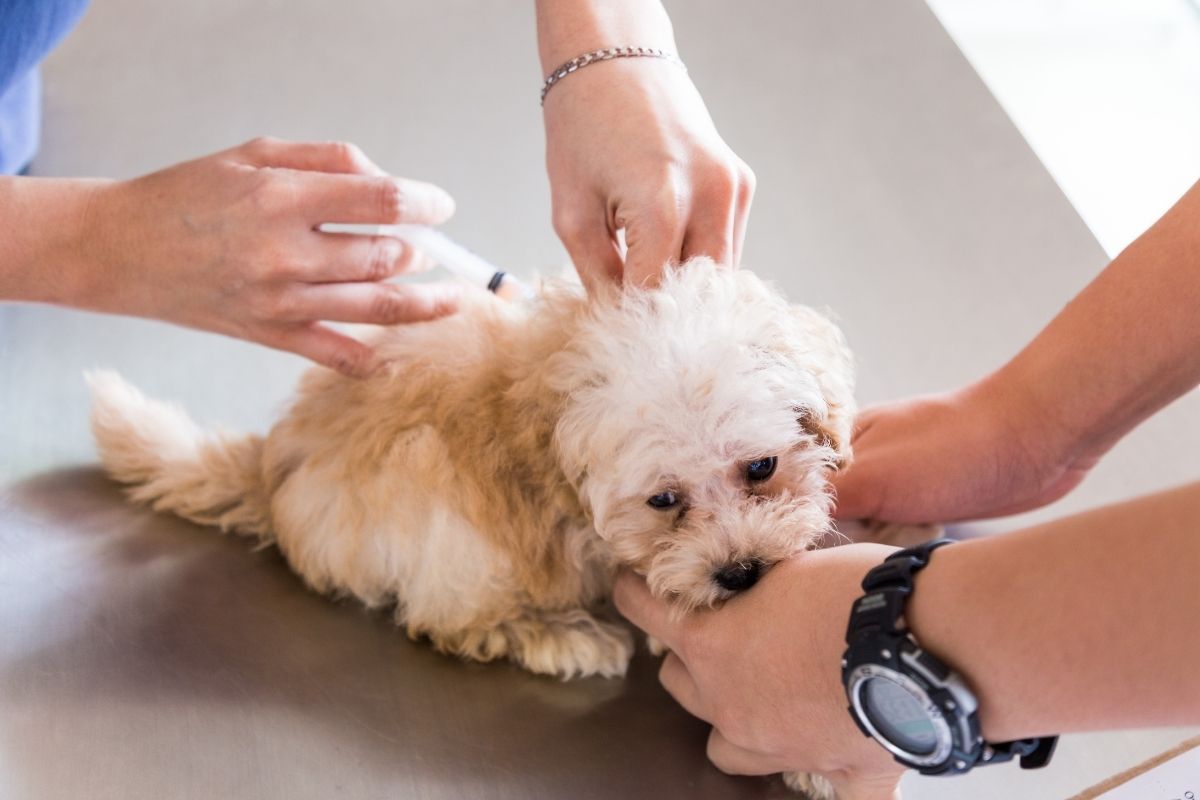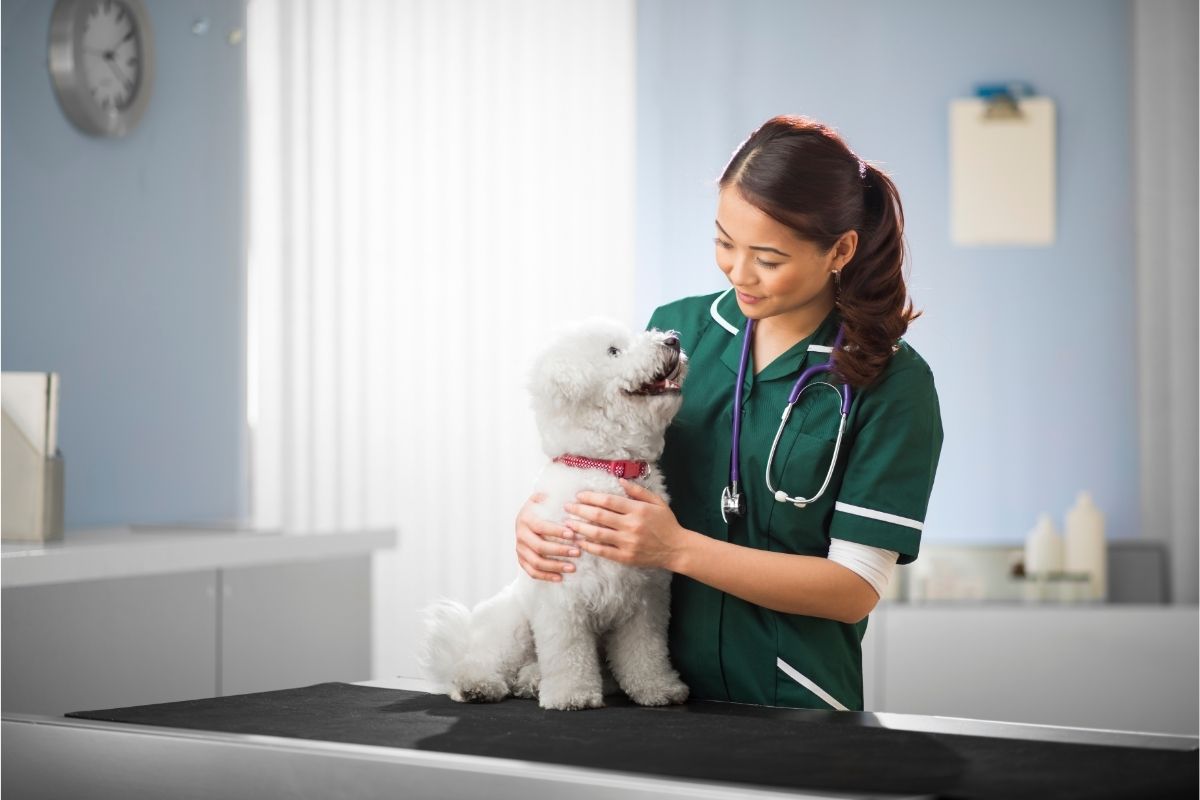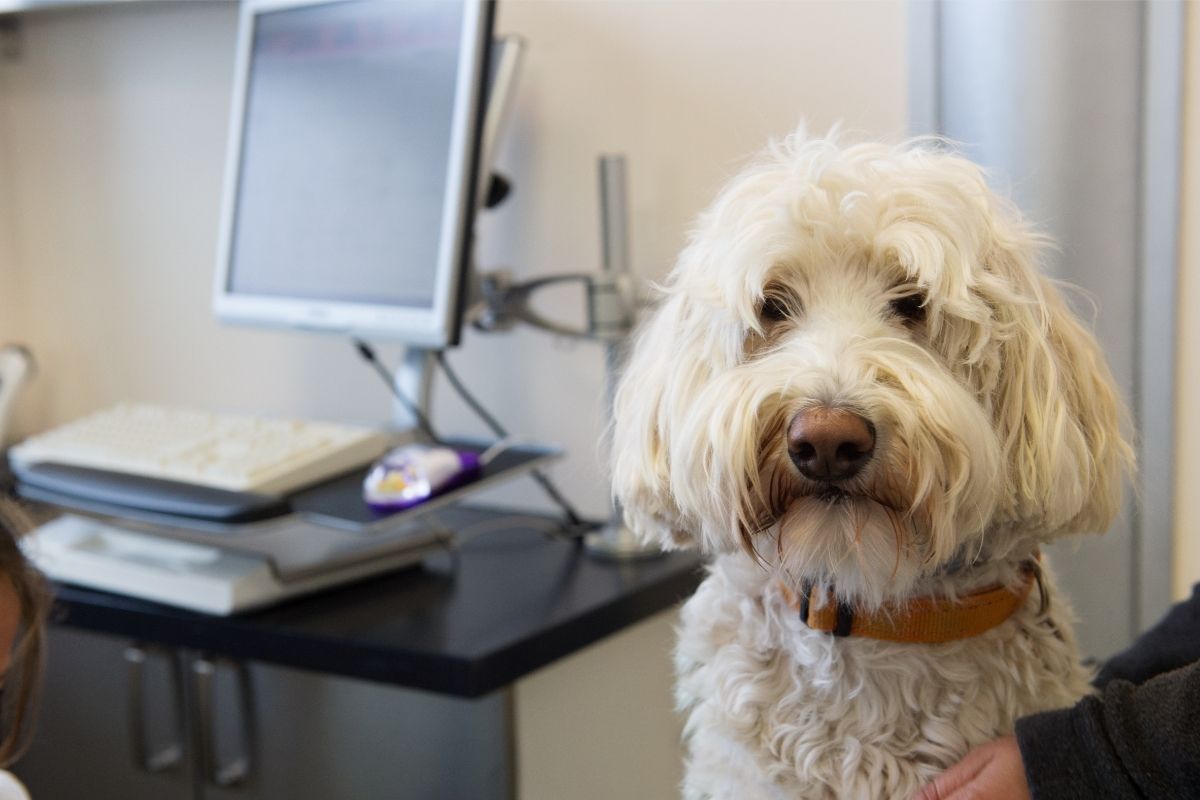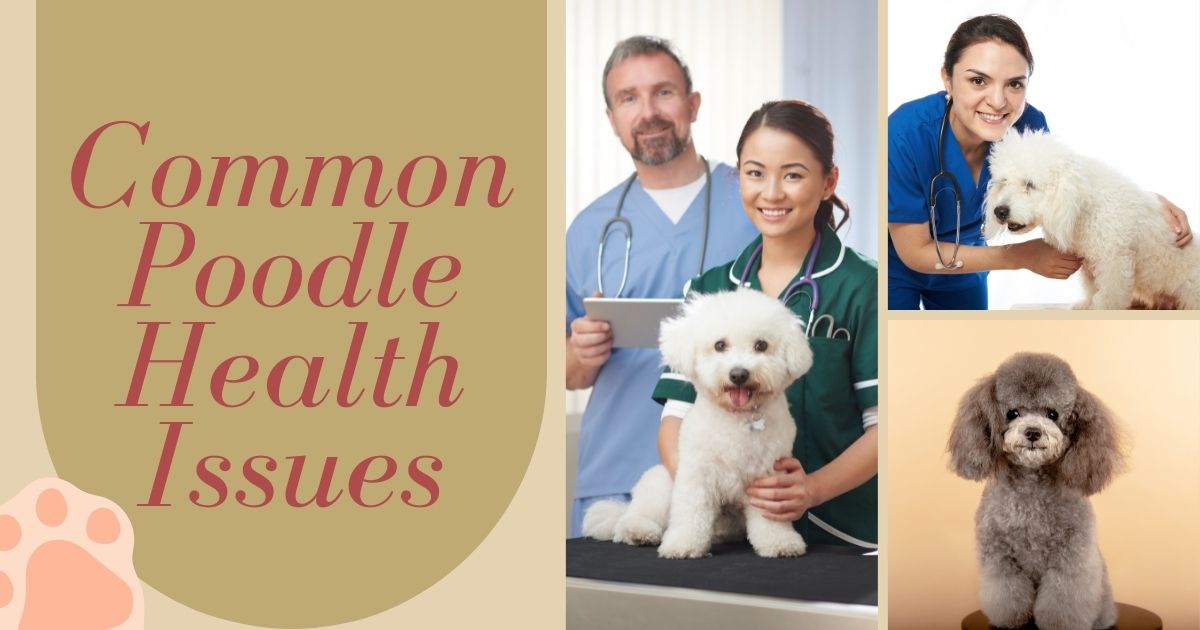Poodles can develop all sorts of Poodle health issues. This is often a result of a combination of factors. As with humans, not all dogs will develop the same health issues due to their genetics and lifestyle.
This means some ailments might not seem like a major issue for your pup but could be something you’d overlook that might come back to bite you. Unfortunately, these issues have led to some common Poodle health problems. Below is an easy-to-understand list of such problems you’re going to want to pay attention to:

The Joy of Owning a Poodle
Poodles are small, intelligent dogs and a popular choice as pets. Generally speaking, Poodles make wonderful family pets. But, you know you’re in for a treat when you’re following your local dog pack and see a small, lively Poodle trotting along at the front of the pack. Here is the joy of owning one:
They are Adorable
Poodles are among the most adorable dogs you’ll ever see. With their hair cut, long eyelashes, and fancy dresses, these doggies have a great reputation for being sweet and kind. As a result, they are popular among dog lovers who think they are the best kind of dogs.
They are Easy to Train
Poodles are extremely intelligent, and they are often one of the most highly recommended breeds for obedience training. This is because they are eager to please their masters and follow instructions. As long as you have patience and a clear idea of what you want your Poodle to do, training it should be a breeze!
You can also browse online to get helpful resources about training a Poodle. If you’re not sure where to start, try searching “how to train a Poodle” in Google or Bing Search (or any other search engine you use). Again, you’ll find lots of useful articles on the subject.
Tips on How to Train Your Puppy
- Be consistent in your commands – Don’t change them around too much, or your puppy will get confused.
- Use rewards when training – Don’t force your puppy into doing something it doesn’t want to do (negative reinforcement). Try using food treats or toys as incentives for good behavior instead.
They Come in All Sizes
Poodles come in all sizes, but they all look like Poodles. This is because they have a thick double coat and are low-shedding. They also come in many colors and coat lengths, such as white, black and tan, brown, apricot, red, cream, and silver. The American Kennel Club recognizes three varieties of Poodles:
Standard Poodle – The standard Poodle is the largest of the three varieties. It has a long head with a square muzzle and ears that hang down to its cheeks. It stands about 21 to 23 inches (53 to 58 centimeters) tall at the shoulder and weighs between 50 and 60 pounds (22.5 to 27 kilograms). The standard Poodle’s long, silky coat comes in many colors.
Miniature Poodle – Miniature Poodles are smaller than standards and have smoother coats with less feathering on their legs and tails. They stand about 12 to 15 inches (30.5 to 38.1 centimeters) tall at the shoulder and weigh between 15 and 18 pounds (7 and 8.1 kilograms).
Their coats come in many colors and are particolored (white with patches of another color). However, you have to be vigilant for miniature Poodle health issues.
Toy Poodle – Toy Poodles are even smaller than miniatures and have smooth coats that come in many colors (white with patches of another color). They stand about 10 inches (25.4 centimeters) tall at the shoulder and weigh between 6 and 9 pounds (2.7 and 4 kilograms).
They Don’t Shed
The Poodle has two different hair types. The first is the soft, curly coat on top of his head and around his face. This type of hair tends to be less prone to matting and tangling than the other type of Poodle hair — the dense undercoat that grows underneath this top layer.
The undercoat makes some breeds of dogs shed more than others, so if you’re looking for a dog that won’t shed much, then a Poodle may be right for you. There are various reasons people choose not to own dogs with any shedding problems.
The most common reason is that many people find themselves covered in dog hair when they come home from work every day. Some people find this unpleasant, while others want to keep their homes clean and tidy without dealing with excessive amounts of dog hair everywhere.
Another reason why people choose not to have dogs with shedding issues is that they have allergies or asthma problems. They don’t want to deal with the dander and hair of owning a dog. No matter your reason for not wanting a dog that sheds, there’s no doubt that the Poodle is a great choice for you. If you’re looking for a hypoallergenic breed that doesn’t shed much, the Poodle is your dog.
How Long do Poodles Live?
Poodles live an average of 14 to 16 years. The French Poodle’s lifespan depends on several factors, including size, coat type, and training. The American Kennel Club recognizes three sizes of Poodles: Toy, Miniature, and Standard. According to the AKC, toy Poodles typically live longer than their larger counterparts.
Toy Poodles have an average lifespan of 15 to 17 years, miniature Poodles live 13 to 15 years, and standard Poodles live 12 to 14 years. Poodle coat type also affects longevity; dogs with curly coats tend to be healthier than wavy or straight coats because they don’t shed as much.
The amount of exercise a Poodle gets also impacts life expectancy; active dogs tend to live longer than those that spend most of their time in the house or yard without much exercise. Finally, Poodles that receive proper training and socialization tend to be well-adjusted and have fewer behavior problems, leading to a longer lifespan.
What are the Most Common Poodle Health Issues?
Poodles are elegant, friendly, and intelligent dogs. Unfortunately, these traits don’t help them live longer. Poodles have a short lifespan and may have health problems that other dog breeds don’t. In addition, Poodles are more prone to certain genetic diseases than other breeds. The diseases include:
Canine Leishmaniasis
Canine Leishmaniasis is one of the most common Poodle health issues. While not all Poodles are prone to getting Canine Leishmaniasis, they are more likely than other breeds to be affected by this condition.
Leishmaniasis is a disease caused by a single-celled parasite called protozoa. There are two forms of parasite that cause Leishmaniasis: Leishmania infantum and Leishmania chagasi.
Both types can infect dogs and other mammals, including humans.
The two types of Leishmaniasis are cutaneous and visceral, affecting the skin and internal organs. Leishmaniasis is common in many parts of the world, including Africa, Asia, South America, and Central America. It is spread by bites from sand flies or kissing bugs (also known as assassin bugs).
These insects feed on blood from an infected animal or human and then pass on the parasite through their saliva into the wound they leave behind when they bite down on their prey. In some parts of the world where dogs stay with animals like goats and sheep, they can also become infected from drinking contaminated milk from these animals.
Some dogs may carry this parasite without ever showing any symptoms, while others will develop severe symptoms over time if left untreated. The severity of symptoms depends on whether it’s a cutaneous or visceral infection and the effect on the dog.
Cutaneous Leishmaniasis is the most common form in dogs and usually only causes mild symptoms. The parasite invades the skin and causes raised; red lesions called nodules or ulcers. These may appear in any part of the body, but you can find them in common areas such as the ears, nose, lips, and footpads.
They are often itchy and painful, but most dogs will recover without treatment. However, the lesions can become infected with bacteria in some cases, leading to pyoderma’s more serious condition.
Visceral Leishmaniasis is less common but much more serious. The parasite invades the internal organs, including the liver, spleen, and bone marrow. This can cause a wide range of symptoms, including weight loss, lethargy, anorexia, vomiting, diarrhea, and seizures.
Visceral Leishmaniasis is fatal in dogs if left untreated. Treatment for both forms of Leishmaniasis involves a long course of antibiotics. The most common antibiotic used is allopurinol, which you should administer for several months to a year.
Some dogs may also require treatment for secondary infections and supportive care to help them recover from the disease.
Cataracts
Cataracts are one of the most common Toy Poodle health problems. A cataract is an opacity in the eye lens that can cause vision problems. Poodles are more likely to develop this condition than other breeds because they have very shallow corneas. Their lens has a high concentration of melanin, making them less transparent than normal eyes.
Cataracts come at any age but usually do not appear until your Poodle is four years old or older. However, suppose you notice any changes in your dog’s vision or behavior, such as seeing fewer objects or vision difficulties? What do you do?
It’s important to see a vet immediately to check your dog’s eyes for cataracts. They will also check on problems that could lead to blindness if left untreated for too long.
If your dog has cataracts, the good news is that a veterinarian can surgically remove them and restore your Poodle’s vision. However, this is a fairly complex and expensive procedure, so it’s important to ensure that you can afford it before proceeding with it.
There are also a few risks involved with any surgery, so be sure to discuss these with your vet before making a final decision.
You can do a few activities to help your Poodle deal with his vision problems. First, one must ensure that it gets plenty of exercise to keep its mind and body active. Another is to provide him with a diet rich in antioxidants to slow the progression of cataracts. Finally, you should also avoid letting your Poodle go outside in bright sunlight.
If you take these steps and keep an eye on your dog’s health, you will help it live a long and happy life despite cataracts.
Gastric Dilation-Volvulus (GDV)
This life-threatening Toy Poodle health issue affects the stomach and results in a twisted stomach. It causes extreme pain to your dog, resulting in bleeding and shock. In some cases, the stomach’s twisting can lead to death within hours.
What are the Causes of GDV?
Gastric dilatation: Your dog’s stomach can stretch due to overeating or eating too fast, which leads to its enlargement (dilatation). This condition occurs mostly in giant breeds such as Great Danes and St Bernards.
Distention caused by water: Dogs drink large amounts of water, leading to distention of their stomachs because they have small intestines and expand quickly.
Dogs with these characteristics are likely to develop GDV if their owners let them drink freely without supervision or if an obstruction in their digestive system prevents them from emptying their bowels properly (e.g., colitis).
Eating habits: If your dog eats only one large meal a day or scavenges for food, they are at a higher risk of developing GDV.
Anatomy: Some dogs are born with an abnormally small stomach and body size, which predisposes them to GDV.
What are the Signs of GDV?
- Bloating: This is the first sign that your dog is developing GDV. You will notice that your dog’s stomach is swollen and tight.
- Unsuccessful attempts at vomiting: Your dog will try to vomit, but it will bring up nothing or little vomit. The stomach is so bloated that the dog cannot vomit properly.
- Restlessness and pacing: Your dog will be restless and pace around as they are in pain.
- Whining or crying: Your dog will cry or whine as the condition is very painful.
- Retching without bringing anything up: You will see your dog retching or dry heaving without anything coming up.
- Pushing with the front legs: Your dog will try to relieve the pressure in its stomach by pushing with the front legs.
If you see these signs, it is important to immediately take your dog to the vet, as GDV is life-threatening.
How is GDV Diagnosed?
The vet will take a history from you and perform a physical examination of your dog. They will also use palpation to check if the stomach is bloated. In some cases, the vets may also use x-rays to check for GDV.
How is GDV Treated?
The only way to treat GDV is through surgery. First, the vet will need to untwist the stomach and then sew it in place to prevent it from twisting again. In some cases, the veterinarians may remove a stomach section.
After the surgery, they will monitor your dog as it will risk developing dehydration, low blood sugar, and low blood pressure. It will also need to be on pain medication and antibiotics.
Prevention
The best way to prevent GDV is to feed your dog smaller meals more frequently than one large meal a day. You should also discourage your dog from eating too fast and drinking lots of water at one go.

Top Tips to Keep Your Poodle Healthy
Keeping your dog healthy can be a full-time job, but our Poodle needs regular help. So here are a few expert tips to keep your Poodle happy, healthy, and attractive.
Feed Your Poodle the Right Diet
Feeding your Poodle the right diet is essential to its health and well-being. There are various Poodle health problems, including kidney disease and hypothyroidism. Feeding your Poodle high-quality dog food will help him avoid these conditions and live a long, healthy life.
Poodles are prone to hip dysplasia and other joint problems because of their long back legs. The best way to prevent Poodle hip dysplasia is by providing your Poodle with an appropriate level of exercise every day.
However, you also need to feed him the right diet to ensure that he has the nutrients for good bone development and joint health. When choosing a food for your Poodle, look for one that contains glucosamine and chondroitin sulphate to help strengthen the cartilage in its joints and prevent arthritis from developing in later years.
You should also consider feeding your Poodle a food with omega-3 fatty acids or fish oil supplements to improve his skin condition, coat quality, and overall health.
Keep Your Poodle Grooming Habits On Track
Here are important tips to keep your Poodle grooming habits on track:
- First, keep your Poodle’s nails clipped and well-trimmed. This will help prevent scratches and cuts from sharp edges and keep the dog’s feet comfortable. If you cannot do this yourself, take your dog to a groomer for nail trimming.
- Brush your dog’s teeth regularly. This will prevent gum disease. It also helps remove plaque and tartar build-up, leading to periodontal disease.
- Bathe your dog regularly with a good quality shampoo designed for dogs. You can use human shampoo, although veterinarians don’t recommend it because it may dry out the skin or cause other skin problems in your pet.
- Trim your dog’s hair regularly if necessary (depending on breed). Trimming a coat will help maintain its proper appearance and shape while keeping it clean and healthy-looking and helping control shedding problems.
Provide Lots of Exercise for Your Poodle
The Poodle is a high-energy dog and is happiest when it has a job to do. The Poodle needs regular exercise, even though it does not look like an active dog. If you have the time to walk your Poodle for at least an hour each day, you will be a good owner for this breed.
The Poodle was originally bred as a water retriever, so playing in the water is always a favorite pastime. Swimming is a great exercise for the Poodle and an excellent way to cool off on hot days. The Poodle also loves to play fetch and catch games with balls or Frisbees.
Brush Your Poodle’s Teeth Regularly
Regular tooth brushing is a good way to prevent Standard Poodle health issues. Since the first step in dental care is regular brushing, check out these tips to help you properly brush your Poodle’s teeth.
Start early: You can start brushing your puppy’s teeth as soon as they come in, usually about four weeks of age. Use a soft-bristled toothbrush and pet toothpaste made for dogs. Brush gently, paying special attention to the gum line where tartar tends to build up.
Brush regularly: Most dogs need to have their teeth brushed at least once a week, but brushing daily may be necessary if your dog has been diagnosed with periodontal disease or other oral health issues.
Use fluoride-free toothpaste: Fluoride can damage tooth enamel and cause discoloration of the teeth. This is when it comes into direct contact with them during brushing or rinsing with water after eating or drinking something containing fluoride additives.
Even if your veterinarian has prescribed a fluoride supplement for your pup, don’t use products that contain fluoride as ingredients in their toothpaste or chewing gums because they can be dangerous.
Don’t use human toothpaste: Human toothpaste contains ingredients that can be harmful to dogs if swallowed, such as fluoride. In addition, the minty flavorings in human toothpaste can upset your dog’s stomach if it swallows a lot of it while you’re brushing its teeth.
Make sure you brush all of your dog’s teeth, not just the ones in the front. It’s important to reach back to the molars at the back of the mouth, where tartar and plaque can build up and cause problems.
If you’re having trouble brushing your dog’s teeth, or if it won’t let you ask your veterinarian about other options for keeping its teeth clean, such as professional dental cleanings or oral rinses.
With regular brushing and good oral care, you can help keep your dog’s teeth healthy and sparkling for years!
Have Your Poodle Checked Regularly by a Vet
It is important to have your Poodle checked regularly by a vet. You should have your dog checked every time you go to the vet for your pets and check the Poodle at least once a year. This is a vital part of keeping your pet healthy and happy.
The vet will be able to tell you how well the Poodle is doing, whether or arising problems, and other precautions to keep them healthy and happy. Then, if there are any problems, these can be taken care of before they become too serious and cause problems for your dog later on.
Regular check-ups are also important because you will know if anything has changed about your dog over time. This way, if any changes might cause problems for them in the future, they can be found out before they become too bad and become difficult to fix.
Keep Your Poodle’s Vaccinations Up to Date
The vaccination schedule for Poodles is similar to that of other breeds, with one difference: a vaccine against Bordetella Bronchiseptica, known as kennel cough. They administer the vaccine with the distemper and parvo vaccines.
The American Kennel Club recommends that puppies receive their first round of vaccinations between 6 and 8 weeks old. Dogs should then be vaccinated every three to four weeks until they are 16 weeks old. The second round of shots is given two weeks after the first.
After that, they should administer boosters once a year (usually in January or February) until your dog reaches maturity at about 18 months of age. After that, you’ll need to give boosters every three years since it takes three years for antibodies to build up in your dog’s system after being vaccinated.
What you Should Know About Being a Poodle Owner
There’s no doubt that Poodles is one of the most popular dog breeds globally. They’re so popular that it’s easy to find books, websites, and even television shows dedicated to giving you everything you need to know about Poodle ownership.
So if you’re considering getting a Poodle, or if you’re just curious about what it’s like to be a Poodle-owner, here are some things that might surprise you:
They’re very smart dogs: Poodles are highly intelligent and can learn new tricks quickly. They also love learning new activities and eagerly participate in training sessions with their owners.
They shed less than other breeds: Many people think shedding is one of the biggest downsides of having a dog — but it doesn’t have to be! Poodles don’t shed like other breeds do, which means they tend not to leave hair everywhere when they shed their coats during spring and fall changes in temperature.
They’re good with kids and other pets: but may not always get along with cats! While Poodles typically get along well with children, toddlers, and other animals like cats, some do not tolerate cats well because they see them as prey animals rather than family members.
They don’t need a lot of exercise: Poodles are relatively low-energy dogs and don’t require a ton of exercise to stay healthy and happy. A daily walk or short play session should be plenty to keep your Poodle content.
Overall, Poodles make great pets for families with children or other pets. They’re smart, relatively low-maintenance, and have a great disposition. If you’re considering adding a Poodle to your family, do your research and find a reputable breeder or adoption agency.
And remember, every Poodle is unique, so don’t hesitate to ask your vet or local animal shelter for advice on choosing the right Poodle for you and your family. Poodles are popular dogs for a reason.
They’re smart, low-maintenance, and have great dispositions. So, if you’re thinking about adding a Poodle to your family, remember to do your research and find a reputable breeder or adoption agency.

Conclusion
Despite various Poodle health problems, Poodles make great pets for the right family. They are intelligent, loving, and playful dogs that can provide years of companionship. If you consider adding a Poodle to your family, consult your veterinarian about the best way to keep your dog healthy and happy.
And remember, because they are prone to some common health issues, it is important to be vigilant in monitoring your pet’s health and seeking treatment when necessary.
